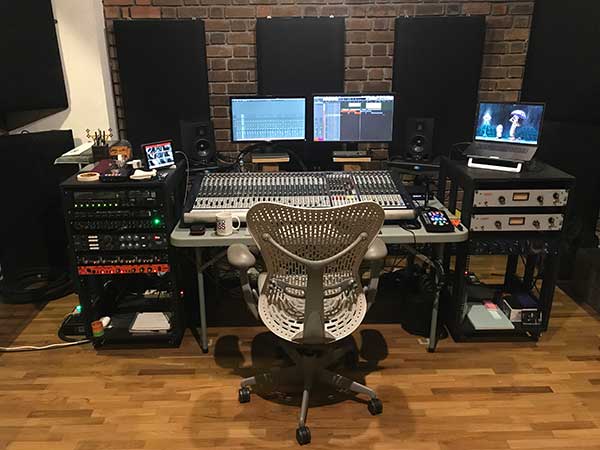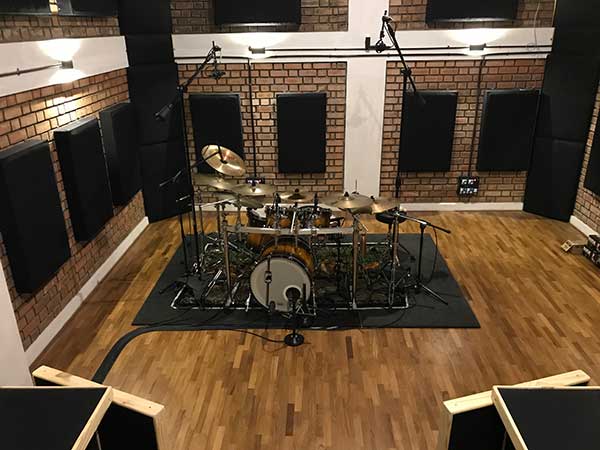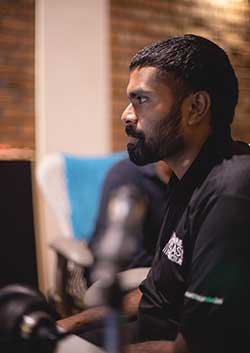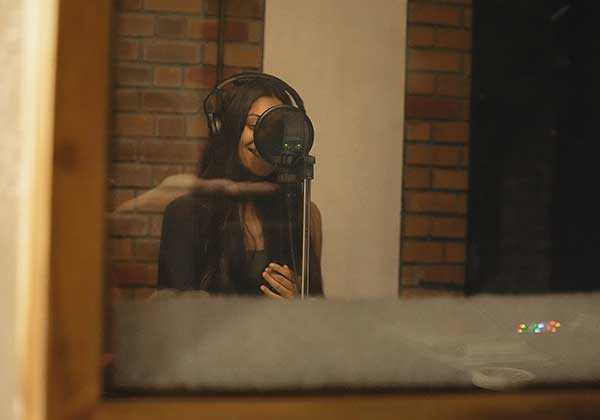Stained Class Productions - Beyond the Realms of Sound

Stained Class Productions is a recording, mixing, mastering and audio editing studio based out of Bangalore. Owner Mrinal N., took time out to talk about the journey of setting up Stained Class Productions. PT reports.
Control Room is flexible and large enough for expansion into a cinema
Meet the father & son duo, Murugan N. and Mrinal N. whose musical influence has been Judas Priest and who have aptly named their studio after the fourth studio album of Judas Priest - Stained Class. Mrinal who manages the technical aspects of the studio is also the in-house engineer, while his father Murugan takes care of the finances.
Opening a studio was imminent for Mrinal. Watching a bunch of ‘album making’ and documentaries of bands on how they made their records, while growing up led him to pursue a career in audio recording, mixing and mastering. One such documentary that inspired him was that of Judas Priest’s British Steel. So while pursuing a degree in Audio engineering, Mrinal started doing freelance work for both live and studio for local Rock & Metal bands in Bangalore like Bevar Sea, Kryptos, Dying Embrace and Shepherd to name a few.
Stained Class Productions was conceptualized while he was doing his VISCOM course and while working for Rock & Metal bands. The musicians, he says, were kind enough to take him to their studios or to their live events and allowed him to work with them. “I got to visit a lot of studios in town in the process and there were always a few minor aspects that used to bother me and made me feel that I’m not getting the best result out of the session,” he continues.
Mrinal realized that none of the recording studios had their own character. “Most of them were padded ‘dead’ rooms (which might work for most engineers),” he recalls. What influenced him to become a recording engineer was the fact that most of the classic albums and songs were recorded with unconventional methods and spaces which in turn would add its own flavor to the recording.
The whole idea behind designing and building his own studio was to have a big Live Room, a regular booth and a decently sized Control Room, which would be acoustically treated rather than just padded walls.
For Mrinal, finding a location was no problem. Mrinal chose his old home located in South Bangalore and converted it into a studio. “We chose this place in particular for multiple reasons, firstly it was a plot that we owned so we could design the space the way we liked it. Secondly, this is a well connected part of the city but mainly this is the part of Bangalore that is relatively more quiet, relaxed and still has some bit of greenery left,” he says.

Live Room primarily used for Drum Tracking, multi-musician performances, live recording of a full band, group vocal performances, choirs. Pictured here is the Drum recording session for Thermal and a Quarter
A few basic requirements were given to the acoustic consultant Rahul Samuel, Founder of LiveEnd and Technical Support Specialist for Meyer Sound. “Mrinal did not ask the usual questions about how much will it cost and how soon can it be built, but instead he focused on questions like: What do I need to create a successful studio? How much space will I need to record live musicians? And I have a building, here are the dimensions. Will this work?”
“We only gave him a few basic requirements that we were not going to compromise on, these were each of our recording rooms should have some character of their own, bare minimum treatment or just enough to take care of the problematic frequencies,” says Mrinal. Mrinal informs us he was specific about having no dead spaces but at the same time did not want it to be overly reverberant. He wanted the main focus to remain on the Live Room and the Control Room that would be used for recoding, mixing and mastering. Other than these specifics, Rahul was given a free hand to come up with a design and solution that he felt would work best for the space. “Mrinal did not ask about dampening or sound proofing. Instead, we discussed factors such as NC, Isolation - both acoustic (air) and structural, and Reverberation Time across the full spectrum that the rooms must achieve. With a design-construction approach like this, you make the best of your resources as you know where you can splurge and where to cut down,” adds Rahul.
A few months after their initial discussion, Rahul recalls his very short conversation with Mrinal, “All he said was, “Hey, I’m in the process of demolishing the existing building (his house), let me know what we should build”. It’s a dream come true for any acoustician but also a huge responsibility and commitment.”
Mrinal’s requirements for the studio were very specific.
- Recording: Live Instruments including drums
- Vocal booth large enough for quieter solo instruments
- Control room that is flexible and large enough for expansion into cinema, if necessary
- Space for artists and clients to be comfortable during extended hours/days both within and around the live rooms
- Living quarters for artists during tracking - everyone needs a break or nap
- Most importantly, a live room, versus what seems to be staple - dead rooms

“Every piece of gear that you will see in our studio is selected after doing multiple research. Every item has a particular character that impressed us and there is still a bunch of gears that is in our wish list.”
MRINAL N
The current space has two Recording Rooms with one common Control Room. The Live Room is isolated completely on a separate floor and the other Recording Room is on the same floor as the Control Room. “We are happy how it turned out and our clients are happy as well with how their instruments sound in the room and with the end results (recordings),” says Mrinal.
SOME HEADS ARE GONNA ROLL - THE DESIGN
The set up and the aesthetics of the studio were a joint decision and collaboration between Mrinal and Rahul. “We asked Rahul if the aesthetics of the studio would work with the treatment and designs he had planned and if it would affect the final response of the room tone,” explains Mrinal.
For Rahul, the fun part was designing the acoustics of the studio. “The studio is very different, the walls were bare and one could see the bricks. The rooms are ‘tuned’ to very precise dimensions and volume, reducing dependency on treatment to manage acoustical energy that would otherwise present itself as unwanted room modes. This design aspect was possible only because we built the structure from ground up. This is an extremely effective approach and rare, but we went all in here,” says Rahul.
The surfaces of the room were carefully designed starting with procuring and caring for the bricks in order to maintain consistent acoustical properties on the surface. All rooms were designed as a room-within-a-room, complete with floating floors even though it is not strikingly evident at first glance. First reflection points were locally treated with custom tuned panels.
The Acoustics
With a live room as large as what Stained Class Production has, it had to be kept flexible. “I had two factors in mind - firstly to keep Mrinal excited about the space over years to come; and secondly to allow for artistic decisions on acoustics,” says Rahul. The excitement and artistic decisions were achieved by keeping the room live and using modular custom-built panels that are movable. “We decided against creating a uniform sounding room, so just by moving source location, orientation and source-mic relation within the room, we were able to achieve different acoustic behavior. The movable modular acoustic panels aid this,” he adds further.
The airlocks are functionally disguised as storage, cupboards, and equipment rooms and go unnoticed yet effectively isolating rooms from each other. The entire designing was done keeping in mind future expansion plans.
“Air locks are very important to any studio were isolation is critical to its function. We spent a lot of time on floor plans making sure we have all the necessary airlocks without losing useable studio floor space. I’m glad to say the extra effort paid off well. The studio feels spacious and lively - not just in the way it sounds but in the physical space which complements the warm but industrial-no-nonsense look and feel,” says Rahul.

Vocal recording session - Alexis D’Souza; the space has two recording rooms with one Common Control Room
The Live Room
The goal was to create a room large enough for a 6 piece band to play simultaneously for live tracking sessions. “We both agreed that this always makes for a better performance than tracking artists and instruments separately,” says Rahul. “Since the building was a multi-level building, we ran into an issue - ceiling height. At this stage, we eliminated two floors of the building. The floors which were originally allotted as housing were now re-allocated for artist residence and to allow for nearly twice the ceiling height in the studio,” Rahul continues.
The Live Room is primarily used for Drum Tracking, multi musician performances, live recording of a full band, group vocal performances, choirs, sometimes just for the big room sound in the recording be it for acoustic guitar performance or guitar amp tracking (live / re-amp). The Live Room is equipped with a 32in & 32out audio breakout box and the Booth is equipped with a 12in and 4 combo I/O ports. The Booth is a relatively smaller space but big enough to house a drum kit if required for a much tighter and focused sound if that is what is required but we usually tack vocals, acoustic guitar, violin, individual percussions etc.
Electrical Power
One of the most overlooked aspects while building studios is electricity. This was factored into the initial structural and electrical design for the building. “We isolated general power and have dedicated power lines for the studio with its own grounding. We designed a robust grounding system that suits the soil conditions at the studio location. These professionally installed systems have a long life and are easy to maintain and monitor. All the equipment stay protected and the noise floor of the systems stays at their lowest,” informs Rahul.
HVAC
Elaborating on the HVAC system, Rahul Says, “We designed the HVAC system keeping the target NC in mind. AHU and heat exchangers were chosen considering the environment and noise criteria in mind. All the ducting was treated acoustically with plenums and baffle boxes to maintain required room to room isolation. The challenge here was the lack of a false ceiling - which was removed to suit the dimensions and volume for the right acoustics. Ideally, false ceilings are used to tuck in the ducts, keeping the noise levels down. But with clever design and adaptations, we achieved targets allowing us to run the HVAC system full-time, during recording sessions as well. This full-time system does not add audible noise into your recordings, and with adequate fresh air input, you won’t feel the well-known ‘studio fatigue’. This keeps the artists and engineers fresh and energetic. This is just as important as using good gear and acoustics.

“The rooms are ‘tuned’ to very precise dimensions and volume, reducing dependency on treatment to manage acoustical energy that would otherwise present itself as not present it as unwanted room modes.”
RAHUL SAMUEL
DELIVERING THE GOODS – THE GEAR
“Every piece of gear that you will see in our studio is selected after doing multiple research, review from fellow engineers and doing demos ourselves (this is mainly possible due to the support we received and continue to receive from the suppliers). Every item has a particular character that impressed us and there is still a bunch of gears that is in our wish list that we’ll be procuring over the course of this year,” reminisces Mrinal.
Some of the gear that Mrinal currently owns was purchased over time when he was doing freelance work. “Once the studio was setup we sourced equipment from ProMusicals, SoundGlitz, Prym Audio & The Inventory.”
“We currently have the ADAM Audio A5X (In L-R setup) with the ADAM Sub8 for low-end extension and are reviewing and demoing Mid-Field monitors,” says Mrinal.
“We at SoundGlitz share special relations with Mrinal & Stained Class Productions. Right from its inception we were instrumental in consulting & giving solutions for his studio & production requirements. We have supplied brands like Sennheiser headphones HD280 Pro, Sennheiser 600 Series Drum Mics, Ashton Condenser mic Stealth, Aston Starlight Stereo Pair Mic, Adams monitor A5X with Sub 8, Konig & Meyer Stands, Warm Audio Pre Amps & compressors, Gator Monitor stands,” says Siddharth Patwa, Director – SoundGlitz.
Solomon Nesaraj, Product Specialist, The Inventory says, “We supplied a few gears to Stained Class Productions. The outboard gear used in the studio was provided by us and we supplied all the Warm Audio gear.” He recalls giving suggestions on what can be updated in the studio, what will suit his workflow and also suggested a couple of modules that would be right for the kind of studio he has.
“I liked the studio, it does not have a traditional studio look, and it is completely different. It looks like a home, a place where I can come and chill out and do my work,” enthuses Nesraj.
RIDING IN THE WIND
The studio is still at its infancy (a year & 5 months roughly). They have a rough road map planned, based on the how the studio grows, the financials and the type of work that they get going forward. “The current setup is more than capable of handling our current workload and the clients with whom we have worked with so far (be it musicians or other engineers) have been satisfied and happy with the gear and the end result,” says Mrinal.
“I am very pleased at how the studio has turned out. Hats off to Mrinal for being open to ideas and going all out on this one. He had very good partners in the construction phase who happily co-operated with an acoustician and never questioned our judgment. This studio, like many other great ones, will continue to evolve especially with a progressive entrepreneur like Mrinal behind it,” concludes Rahul.